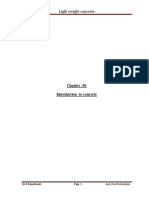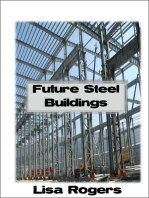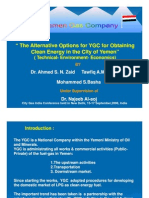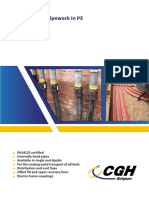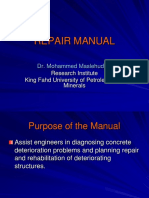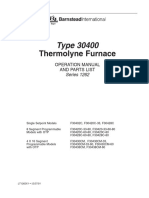What Is Steel Fiber Concret
What Is Steel Fiber Concret
Uploaded by
Alfin Rico SimanjuntakCopyright:
Available Formats
What Is Steel Fiber Concret
What Is Steel Fiber Concret
Uploaded by
Alfin Rico SimanjuntakOriginal Description:
Original Title
Copyright
Available Formats
Share this document
Did you find this document useful?
Is this content inappropriate?
Copyright:
Available Formats
What Is Steel Fiber Concret
What Is Steel Fiber Concret
Uploaded by
Alfin Rico SimanjuntakCopyright:
Available Formats
What is Steel Fiber Concrete?
Uses and
Applications
Steel fiber concrete flooring: Uses and Benefits
BY JUAN RODRIGUEZ
Updated April 14, 2018
Steel fiber concrete flooring can provide superior resistance to minimize cracks in
hardened concrete, as well as maximum resistance to withstand heavy loads, either
dynamic or static. If you decide to use steel fiber concrete flooring, you can select to
use a ‘joint-less floor’. Joint-less floors are floors that have minimal joints, providing
spaces without joints as large as 40 or 50-meter span wide.
Steel fiber dosage will vary greatly upon the project intended use, and the types of
mesh being replaced. Common dosages are in the range between 20-30kg/m3 to
40-50kg/m3 for joint-less floors. Trowelling concrete will help to embed steel fibers
into the concrete surface producing a better finish product. Steel fibers will enhance
to crack resistance of the concrete, and they can also be used to replace or
supplement structural reinforcement. It only can be done through a structural
engineer and with proper guidance.
How and When the Fiber is Added?
Typically the fibers are added at the batch plant, just after all concrete aggregates
are being mixed. Some people would request to have the fiber added at the jobsite,
but then the QA/QC should have more control on how much fiber is added. The steel
fiber manufacturer can provide guidance on how to mix and the amount needed to
obtained desired results. Be aware that if you add too much fiber, it might show up at
the surface when finishing the concrete so be cautious about the amounts being
mixed.
How Much Should I Be Charged for Using It?
In general, and depending on the type of steel fiber used, it can add between $6 to
$10 per cubic yard on top of the ready-mix concrete cost. This cost is based on the
assumption that you are using 1.5 pounds per cubic yard of concrete.
How is the Workability Affected?
If you opt-in to add fiber to your concrete mix, be aware that there will be some
changes on the way you manage this concrete. First of all, the slump will be affected,
and it is recommended to add a superplasticizer to enhance the slump and make the
concrete a little more fluid. Not all steel fiber can be used as a substitute for steel
reinforcement, so make sure that your structural engineer has reviewed and
analyzed the loads before proceeding.
Where to Use Steel Fiber Concrete Floors
Typical applications for steel fiber concrete flooring can be found on parking lots,
playgrounds, airport runways, taxiways, maintenance hangars, access roads, and
workshops. This method is also widely used for port pavements, container storage
and handling areas, bulk storage warehouses and military warehouses. Steel fiber
reinforced concrete is commonly used in tunnel construction, as it provides additional
flexural strength, reduces shrinkage cracking and reduces permeability.
Advantages of Steel Fibers in Concrete
Several advantages can be obtained from this product, for example:
Increased load bearing capacity of concrete
Reduction of concrete slab thickness
Load capacity is not diminished by concrete cracks
Increased durability
Low maintenance costs
Improved flexural properties
Reduced absorption of water, chemicals, etc.
Can be used on fast track schedule
Easier positioning of joints
Reduced site labor for managing steel reinforcement
Reduced project costs
Increased impact and abrasion resistance
Even distribution of fibers throughout the concrete
Tougher surface with fewer bleed holes
Savings will be greater for heavier crack control systems
Source:
https://www.thebalancesmb.com/what-is-steel-fiber-concrete-uses-and-applications-844458
You might also like
- Steel Fiber Reinforced ConcreteDocument26 pagesSteel Fiber Reinforced ConcreteJames Augustine100% (1)
- Post Tensioning in Building StructuresDocument21 pagesPost Tensioning in Building StructuresLuan Truong VanNo ratings yet
- Dimensions, Weights and Properties of Special and Standard Structural Steel Shapes Manufactured by Bethlehem Steel CompanyFrom EverandDimensions, Weights and Properties of Special and Standard Structural Steel Shapes Manufactured by Bethlehem Steel CompanyNo ratings yet
- Aspen Capital Cost EstimatorDocument3 pagesAspen Capital Cost Estimatormehfuzansari1No ratings yet
- FRP NotesDocument11 pagesFRP NotesMohammed ImranNo ratings yet
- Final Project-1Document91 pagesFinal Project-1civilNo ratings yet
- Unit6 MCNDocument29 pagesUnit6 MCNPravesh GautamNo ratings yet
- Building Materials 3,4,5Document17 pagesBuilding Materials 3,4,5muthukumarNo ratings yet
- 2nd ReviewDocument24 pages2nd ReviewArief R IFNo ratings yet
- Concrete Basics PDFDocument30 pagesConcrete Basics PDFDarshan Rokztar100% (1)
- Steel Fibre Concrete Composites For Special ApplicationsDocument213 pagesSteel Fibre Concrete Composites For Special Applicationshamsanram100% (3)
- Benefits of SFRCDocument17 pagesBenefits of SFRCShubhayu_duttaNo ratings yet
- Final ProjectDocument33 pagesFinal ProjectYuvresh BansalNo ratings yet
- Concrete AssignmentDocument24 pagesConcrete AssignmentPushpesh RanjanNo ratings yet
- Concrete Admixtures: Set-RetardingDocument4 pagesConcrete Admixtures: Set-RetardingJaime SobredoNo ratings yet
- College NotesDocument6 pagesCollege NotesMohd AhsanNo ratings yet
- What Are The Reasons of Establishing Minimum Area of Reinforcement and Maximum Area of Reinforcement?Document9 pagesWhat Are The Reasons of Establishing Minimum Area of Reinforcement and Maximum Area of Reinforcement?Ganesh.RajanNo ratings yet
- Fibre Reinforced ConcreteDocument6 pagesFibre Reinforced ConcreteFranklyn GenoveNo ratings yet
- Reinforcing Steel Design GuideDocument18 pagesReinforcing Steel Design GuidewillchamNo ratings yet
- Kinga-Prc-Assignment 1Document3 pagesKinga-Prc-Assignment 1LJ IDANE ARANASNo ratings yet
- Prestressed ConcreteDocument18 pagesPrestressed ConcreteLarete PaoloNo ratings yet
- RC Notes by Engr. GREGDocument49 pagesRC Notes by Engr. GREGMichael SuanNo ratings yet
- Acknowledgement: M.R. Head of Civil Engineering Department, For Inspiring Take This Project. I Also ExpressedDocument18 pagesAcknowledgement: M.R. Head of Civil Engineering Department, For Inspiring Take This Project. I Also ExpressedRicky RickxNo ratings yet
- Typologies of CementDocument250 pagesTypologies of CementRHYME KIDSNo ratings yet
- Sulphur Impregnated ConcreteDocument6 pagesSulphur Impregnated ConcreteAnusmita DuttaNo ratings yet
- BtechhDocument7 pagesBtechhcorbitecoNo ratings yet
- JL Summer 2012 6Document6 pagesJL Summer 2012 6lukas0910No ratings yet
- Why Steel Reinforcement Is Needed in Concrete SlabsDocument2 pagesWhy Steel Reinforcement Is Needed in Concrete SlabsAuYongTheanSengNo ratings yet
- Fibre Reinforced Concrete FRC Ijariie4483Document7 pagesFibre Reinforced Concrete FRC Ijariie4483Devesh Kumar PandeyNo ratings yet
- Cec 313 Lect NoteDocument10 pagesCec 313 Lect NoteSamson Mide FolorunshoNo ratings yet
- RCC2Document18 pagesRCC2Mangam RajkumarNo ratings yet
- Mahalakshmi R Nair AssignmentsDocument17 pagesMahalakshmi R Nair AssignmentsMahalakshmi R NairNo ratings yet
- 09 - Chapter 1Document16 pages09 - Chapter 1pratik chauhanNo ratings yet
- Effect of Fibers in Concrete Composites: International Journal of Applied Engineering Research January 2015Document13 pagesEffect of Fibers in Concrete Composites: International Journal of Applied Engineering Research January 2015Aika LorenNo ratings yet
- Reinforcement C-WPS OfficeDocument7 pagesReinforcement C-WPS OfficeNoah Oluwatoyin AderiyikeNo ratings yet
- Wah Campus Assignment No. 01 Properties of Concrete: NamesDocument9 pagesWah Campus Assignment No. 01 Properties of Concrete: NamesYasir MalikthNo ratings yet
- INTRODUCTIONDocument10 pagesINTRODUCTIONSahil BadgujarNo ratings yet
- Behaviour of Crimped Steel Fiber in ConcreteDocument11 pagesBehaviour of Crimped Steel Fiber in ConcreteRainakNo ratings yet
- Steel Fiber Reinforced ConcreteDocument13 pagesSteel Fiber Reinforced ConcretePranav Dhakulkar PDNo ratings yet
- Lec 3 CE 806 RCM Beams - Working Stress MethodDocument14 pagesLec 3 CE 806 RCM Beams - Working Stress MethodwasimkhaliqNo ratings yet
- Civil Fiber Reinforced Concrete ReportDocument12 pagesCivil Fiber Reinforced Concrete ReportPANKAJ KUMAR BTechNo ratings yet
- Chapter 1 Introduction To Reinforced Int PDFDocument53 pagesChapter 1 Introduction To Reinforced Int PDFAl Joshua ApuraNo ratings yet
- Reinforced Concrete Design IDocument27 pagesReinforced Concrete Design IKhaled Fada'aqNo ratings yet
- FRCFRCDocument11 pagesFRCFRCdhananjay kumarNo ratings yet
- Articles Difference Between RCC and Prestressed ConcreteDocument12 pagesArticles Difference Between RCC and Prestressed ConcreteLyka Jane PesiganNo ratings yet
- Basics of Fibre Reinforced ConcreteDocument42 pagesBasics of Fibre Reinforced ConcreteM ShahidNo ratings yet
- Fibre Reinforced Concrete: A Consise ReportDocument5 pagesFibre Reinforced Concrete: A Consise ReportSaleem MohammedNo ratings yet
- Reinforced Concrete Design :introductionDocument52 pagesReinforced Concrete Design :introductionRandy PolicarpioNo ratings yet
- Reinforcement (Steel Rebar)Document7 pagesReinforcement (Steel Rebar)shamelNo ratings yet
- Innovation in Composite ConstructionDocument6 pagesInnovation in Composite ConstructionnicholasNo ratings yet
- Project Report On Polymer Fibre Reinforced Concrete PavementsDocument41 pagesProject Report On Polymer Fibre Reinforced Concrete PavementsShilankarMurti82% (17)
- Project Book .Docx 3 WORD - Docx NewDocument78 pagesProject Book .Docx 3 WORD - Docx NewMuthaiyaNo ratings yet
- HB Assignment 2Document11 pagesHB Assignment 2Himanshu BishnoiNo ratings yet
- Villanueva Assignment1 PRCDocument5 pagesVillanueva Assignment1 PRCARC VILLANUEVANo ratings yet
- SFRCDocument37 pagesSFRCKarthika SNo ratings yet
- Reinforced ConcreteDocument12 pagesReinforced ConcretehistorymakeoverNo ratings yet
- Comparison of Performance of Standard Concrete and Fibre Reinforced Standard Concrete Exposed To Elevated TemperaturesDocument7 pagesComparison of Performance of Standard Concrete and Fibre Reinforced Standard Concrete Exposed To Elevated TemperaturesAJER JOURNALNo ratings yet
- Thesis On Steel Fiber Reinforced ConcreteDocument5 pagesThesis On Steel Fiber Reinforced ConcreteBuyCustomEssayEverett100% (1)
- REG630 Appl 757582 ENbDocument64 pagesREG630 Appl 757582 ENbaalinares1No ratings yet
- Yemen Gas CompanyDocument38 pagesYemen Gas CompanyPratik PatelNo ratings yet
- ThesisDocument230 pagesThesisbharskar jyoti SaikiaNo ratings yet
- ICT For IGCSEDocument218 pagesICT For IGCSEMohammed Bakri Algadi100% (1)
- Single-Direction Thrust Ball BearingsDocument19 pagesSingle-Direction Thrust Ball Bearingserwin erwinNo ratings yet
- V500 Pneumatic Angle Seat ValvesDocument1 pageV500 Pneumatic Angle Seat ValvesPedroNo ratings yet
- Maaz Alam Reporting From PeshawarDocument9 pagesMaaz Alam Reporting From PeshawarZeshanNo ratings yet
- Instruction Sheet: Applies To SBS 320 To 900Document4 pagesInstruction Sheet: Applies To SBS 320 To 900Alexandru BaciuNo ratings yet
- Analysis On The Spinning Process and Properties of Tencel YarnDocument8 pagesAnalysis On The Spinning Process and Properties of Tencel Yarnkhalil khanNo ratings yet
- Brief Industrial Profile of THANJAVUR District 2015-16Document24 pagesBrief Industrial Profile of THANJAVUR District 2015-16Mangala GowriNo ratings yet
- Ec025 PDFDocument16 pagesEc025 PDFWangunNo ratings yet
- Katalog HalockDocument4 pagesKatalog Halockwarung1bensinNo ratings yet
- Repair Manual King Fahd SaDocument27 pagesRepair Manual King Fahd SaAkhilesh DwivediNo ratings yet
- Cement PlantDocument232 pagesCement PlantAnonymous iI88Lt100% (1)
- PW SeriesDocument8 pagesPW SeriesMt GrNo ratings yet
- WELDING CONSUMABLES-Hardfacing PDFDocument18 pagesWELDING CONSUMABLES-Hardfacing PDFmanuel_plf100% (1)
- CY6252 Chemistry For Technologists L T P C 3 0 0 3 Unit I Water 9Document1 pageCY6252 Chemistry For Technologists L T P C 3 0 0 3 Unit I Water 9Abner kolinNo ratings yet
- Diagrama de MuflaDocument56 pagesDiagrama de MuflaitzelNo ratings yet
- Basoflux Paraffin Control For The Oil IndustryDocument6 pagesBasoflux Paraffin Control For The Oil Industryyugatha100% (1)
- Alfa Laval LKB Automatic or Manual Butterfly Valve and LKB LP Low Pressure Butterfly Valve - Instruction Manual - Ese02446en PDFDocument70 pagesAlfa Laval LKB Automatic or Manual Butterfly Valve and LKB LP Low Pressure Butterfly Valve - Instruction Manual - Ese02446en PDFvmeottiNo ratings yet
- 2006 Book ProductConceptDesign PDFDocument210 pages2006 Book ProductConceptDesign PDFFahdAhmedNo ratings yet
- TPL - 24VDocument3 pagesTPL - 24VtoppowerNo ratings yet
- Nema 250 PDFDocument42 pagesNema 250 PDFalexdelarosaU12No ratings yet
- Silsteel Data Sheet PDFDocument1 pageSilsteel Data Sheet PDFtyoNo ratings yet
- Uapro Dig13 PDFDocument32 pagesUapro Dig13 PDFG-SamNo ratings yet
- Compressor - Tech Spec - Signed & Stamped Dated 14.08.2017Document13 pagesCompressor - Tech Spec - Signed & Stamped Dated 14.08.2017ashish kumar pandeyNo ratings yet
- Chapter 5.0.2018 - Retaining WallDocument36 pagesChapter 5.0.2018 - Retaining WallHawaiiChongNo ratings yet
- 5S PresentationDocument90 pages5S Presentationsystem16No ratings yet
- Technical Report For A Structural Design ProjectDocument95 pagesTechnical Report For A Structural Design ProjectHayman AhmedNo ratings yet










